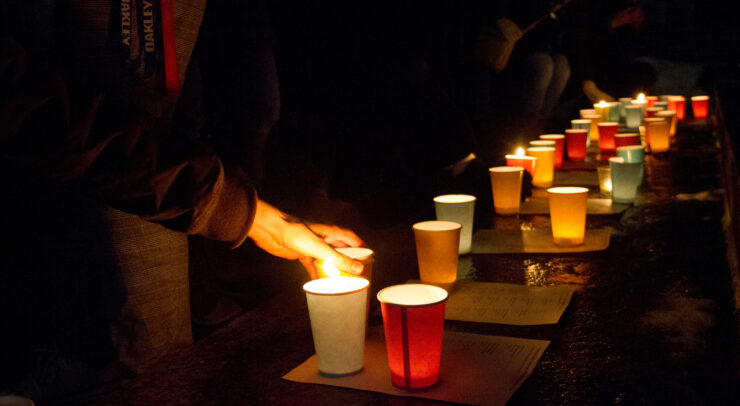Finding a healthy middle ground between demonizing and glorifying alcohol use
As you walked through the University Centre this past week, you might have noticed posters all over the walls beckoning students to parties at clubs and bars all over the city. Or the tables boasting Smirnoff swag, or information about the club Kavali.
And later in the evening, there’s a good chance you noticed the elated yelling from students taking to the streets to head out to a party or two.
None of this in and of itself is unusual. After all, the Canadian Centre on Substance Abuse’s (CCSA) Cross-Canada Report on Student Alcohol and Drug Use shows that there is a consistency of alcohol and drug use across provinces, as well as gender.
It seems that the prominent drinking culture at the University of Ottawa, and post-secondary schools across the country, is pervasive and here to stay.
On the other hand, as you transitioned to post-secondary school, you likely heard statements like “don’t drink” from just about every authority figure in your home and campus life.
And although these two takes on alcohol use lie at the extremes, neither are conducive to the conversation that needs to be had.
Substance use problems do fall under mental illness, but can easily be overlooked on a campus inundated with encouragement for alcohol consumption, and chastised by authority figures who discourage excessive drinking on campus. This can leave students who deal with alcohol use problems in a precarious position.
Though discussing the fine line between having one too many and misuse or addiction can be sobering, the Fulcrum encourages students to reformulate the extreme narratives around alcohol to make a little room for those who need support.
What’s the big deal about students misusing alcohol?
According to the Chief Public Health Officer’s 2015 Report Alcohol Consumption in Canada, although the observed rates of drinking in a 2013 survey among all age groups remained relatively constant, the rate of risky drinking was substantially higher in young adults aged 20 to 30 in the same survey.
This alone isn’t a good thing, but, when paired with the vulnerability of students to experience a mental illness, the situation can be especially problematic.
According to the Centre for Addiction and Mental Health (CAMH)’s statistics on mental illness and addiction, those with a mental illness are twice as likely to have a substance use problem compared to the general population. Specifically, at least 20 per cent of people with a mental illness have a co-occurring substance use problem.
According to the same CAMH report, young people aged 15 to 24 are more likely to experience mental illness and/or substance use disorders than any other age group.
Dr. Michael Krausz, of the University of British Columbia’s Department of Psychiatry, emphasizes that adolescence and young adulthood is a pivotal time when it comes to mental health.
“What we know is that nearly all mental illness, including substance use, are having their onset in the late adolescence, and early adulthood,” says Krausz. His statement is quantified by the CAMH report, which says that 70 per cent of mental health problems have their onset at this time.
In a similar vein, the CAMH data show that people with substance use problems are up to three times more likely to have a mental illness, while more than 15 per cent of people with a substance use problem have a co-occurring mental illness.
With increasing mental health problems among students on campuses, as well as numerous sizeable barriers to accessing campus mental health care, not to mention the pervasive drinking culture, our post-secondary institutions can be fertile grounds for the development of alcohol misuse.
Social situation critical to stopping the cycle of misuse
Dr. Tim Dyck of the University of Victoria’s Centre for Addictions Research of British Columbia believes that we can learn a lot about alcohol misuse by looking at a student’s social environment.
“They’re in a situation where they’re trying to establish social networks, they’re trying to form their own identity in relation to other people, they’re trying to find the group they fit into to be a part of,” says Dyck.
“In our culture, you generally get the message from the media or advertising by the alcohol industry, and a lot of other ways, that alcohol is critical for socialization.”
When it comes to the university atmosphere, and society as a whole, Krausz thinks that we aren’t very good at addressing the problem of substance use and addiction, or encouraging people to seek help for it.
Krausz says that the peer group is more critical for reinforcing specific behaviours than authority is, and says that some peer groups can create situations where students view their substance use as normal.
“If students are part of a group where, let’s say, at least heavy use is part of their norms or their behaviours, alcohol use may be a prerequisite to be a part of a specific social network, then the risk is higher to drink heavily or develop more risky consumption.”
Dyck also emphasizes the importance of the peer group, and says it is common for young people to overlook the extent to which they are using alcohol in ways that are bringing about problems or difficulties for them.
“There tends to be, on the part of post-secondary students, a misperception of the norm,” he says. “They tend to overestimate the degree to which their peers around them are using, the extent of that use, and the degree to which their peers approve of unrestrained and unregulated use.”
Krausz notes that students may be drawn back to using alcohol because of certain advantages they may experience while under the influence, such as an escape from shyness or social anxiety.
“We as adults, as teachers, are not really offering them a lot of opportunities to reflect (on their use of alcohol) in an appropriate way.”
Developing a counter-culture around substance use
For many, that moment of reflection may come at a higher cost than a bad hangover.
According to the CCSA’s Canadian Drug Summary report on alcohol, the most common offence in Canada’s adult criminal court is driving while impaired by alcohol.
The most recent breakdown of the cost of alcohol misuse in Canada, as featured in the Chief Public Health Officer’s 2015 Report Alcohol Consumption in Canada, shows that in 2002 the total cost to the government was $14.6 billion.
Though the costs of misuse can be high and varied, Dyck believes that “fear-mongering” is far from the best way to reach young minds.
“You often hear about how concerned professionals and practitioners are that up until 25 the brain is still developing, so young people who are using alcohol are running a risk of compromising their development,” he says.
“I think there’s truth to that… (but) when you engage in that as your sole or your major way of communicating with young people, you won’t get the reaction you’re looking for.”
So what is the best way to achieve a healthy awareness among students? Krausz believes the key lies in early intervention, “so that young people who have questions can really get informed and get access to peer conversation about substance use.”
He also notes that breaking down the stigma around alcohol misuse as a mental illness is important, as “labelling” and “stigmatizing” can make a person’s recovery more difficult.
One way Dyck suggests removing negative connotations around these problems is avoiding using the word “abuse” when referring to a person’s struggle with drugs or alcohol. He says that this term isn’t used in official diagnostic language anymore, and beyond that he believes that the word can insinuate certain things that bring more harm than good.
“When I think of the word abuse I think of abusing children, or spouses, or maybe abusing a privilege or a system, and all of those sorts of usages really contain the notion of real moral injustice, or victimization of someone or something involved,” he says.
“So the person involved in that is kind of viewed as a culpable perpetrator.”
Dyck also says that school policy can play a role in either supporting or isolating people with alcohol use problems.
“I think in our institutions, when we have kids that tend to get a little bit marginalized and ostracized, those are the ones who become more vulnerable to more problematic patterns of youth,” he says.
“And policies that tend to increase that distance, you know, suspension or expulsion, actually don’t do these young people any favours at all.”
Dyck urges universities to try their best to think about whether their policies help these people to integrate, or create a situation that makes them more isolated.
Finally, Dyck says that prevention or re-integration initiatives in post-secondary contexts should aim to correct the common misperceptions around the norms of alcohol consumption.
He references experiential studies where students are told they are drinking alcohol, and end up acting less inhibited without consuming anything alcoholic. Based on this, he says it is possible for students to build the skills for interaction that isn’t reliant on substance use.
“I think you can give them the opportunity to think about how they can maybe derive the benefits they get in other ways that don’t involve alcohol, or help them to build the skills they certainly can develop without needing to rely on alcohol.”
Finding the healthy middle ground
All of that said, there’s no reason to completely write off alcohol. After all, substance use has been going on for thousands of years in all sorts of different cultures and civilizations, for reasons they considered advantageous.
Dyck puts it simply, in that he likes to “recognize that positive orientation that people have, but also recognize the reality that harm can result from it to themselves and others around them.”
With that dual discussion in mind, at the U of O there are lots of opportunities to get your buzz on, but there are also resources in the area for those who might need a little time to reflect.
The University of Ottawa Health Services’ Mental Health Department offers a maximum of 8–10 sessions for substance use problems, and the Sandy Hill Community Health Centre provides educational sessions on drugs and alcohol, as well as confidential individual or family counselling services.
But Dyck emphasizes that treatment for problems related to alcohol use don’t have to be the formal interventions that we tend to picture when we think of treatment. He says that informal methods, such as “consultation and dialogue” with other students can help young people get on track.
If anything is evident from speaking with both of these researchers, it is that peer support makes a world of a difference.
Alcohol is a part of the student experience, but nothing is ever one-sided. Students are increasingly open about supporting their friends with mental health struggles; our next hurdle might just be extending this support to our peers that don’t fit the stereotype of the party-hungry, binge-drinking student.
As Dyck puts it, prevention of really severe extended problems with alcohol can come down to “the provision of a nurturing environment,” and helping students to become increasingly confident in their own capacity to act—with or without a little liquid courage.





